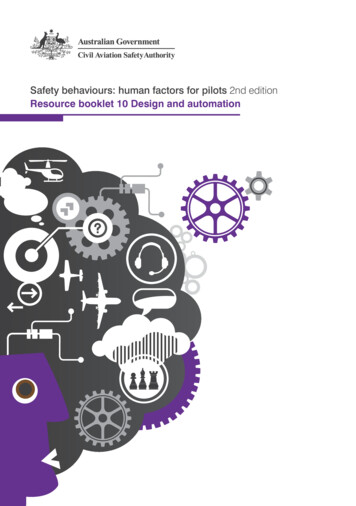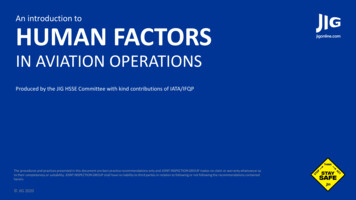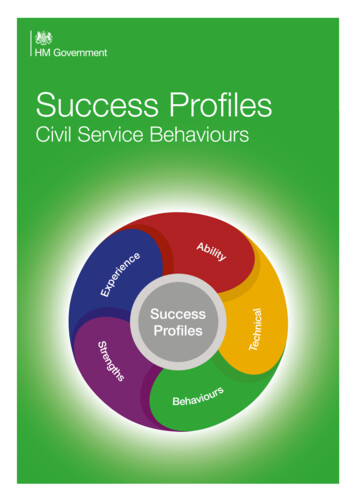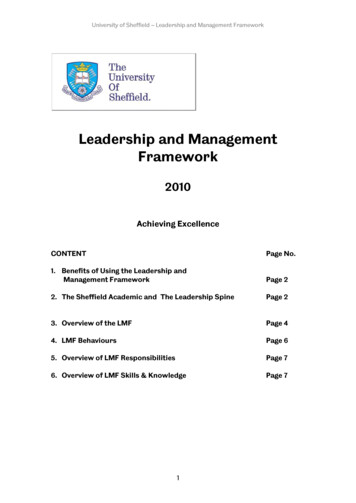
Transcription
Safety behaviours: human factors for pilots 2nd editionResource booklet 10 Design and automation
2 Safety behaviors: human factors for pilots 2nd edition 2019 Civil Aviation Safety Authority AustraliaFirst edition of Safety Behaviours: Human Factors for Pilots (2009), Second edition kit (2018) ISBN: 978-1-921475-54-2Book 1: ISBN 978-1-921475-55-9 (paperback) ISBN 978-1-921475-56-6 (pdf), Book 2: ISBN 978-1-921475-57-3 (paperback) ISBN 978-1-921475-58-0 (pdf),Book 3: ISBN 978-1-921475-59-7 (paperback) ISBN 978-1-921475-60-3 (pdf), Book 4: ISBN 978-1-921475-61-0 (paperback) ISBN 978-1-921475-62-7 (pdf),Book 5: ISBN 978-1-921475-63-4 (paperback) ISBN 978-1-921475-64-1 (pdf), Book 6: ISBN 978-1-921475-65-8 (paperback) ISBN 978-1-921475-66-5 (pdf),Book 7: ISBN 978-1-921475-67-2 (paperback) ISBN 978-1-921475-68-9 (pdf), Book 8: ISBN 978-1-921475-69-6 (paperback) ISBN 978-1-921475-70-2 (pdf),Book 9: ISBN 978-1-921475-71-9 (paperback) ISBN 978-1-921475-72-6 (pdf), Book 10: ISBN 978-1-921475-73-3 (paperback) ISBN 978-1-921475-74-0 (pdf)Workbook: ISBN 978-1-921475-75-7 (paperback) ISBN 978-1-921475-76-4 (pdf)For further information or additional copies, visit CASA’s website www.casa.gov.au/hfNotice: The information contained in this document was correct at the time of publishing and is subject to change without notice. It has been prepared byCASA Safety Promotion for educational purposes only. This guide outlines basic procedures—it should never be used as a replacement for offcial manualsor procedures. Reference should be made to the appropriate procedures at all times prior to the use of this information.The Civil Aviation Safety Authority is responsible for the safety regulation of Australia’s civil aviation operators, and for the regulation of Australian-registeredaircraft outside Australian territory.Unless noted otherwise, copyright in this work is owned by CASA. This work is licensed under a Creative Commons Attribution—4.0 International Licence,with the exception of the Commonwealth Coat of Arms; CASA’s logo; any third party material; any material protected by a trademark, and any images and/or photographs.Enquiries about this licence and any use of this work can be sent to Corporate Communications at PublicEnquiries@casa.gov.au. Use of any part of this workmust include the following attribution: ‘Source: Civil Aviation Safety Authority’. Before using any third party material in this work, you must contact the owningparty directly to seek permission to use it.1802.2344image: Adobe Stock xiaoliangge
Resource booklet 10 Design and automationSince the early years of poweredfight, there has been muchdiscussion about how designand automation infuence pilotworkload and fight safety.The interaction between peopleand machines has generatedongoing and extensive research.This booklet considers thegood, the bad and the uglywhen it comes to aircraft designand automation. It stresses theimportance of understandingthe strengths and limitationsof technology, and trainingwhich takes these into account. 3ContentsIntroduction4Advances in safety4Evolution of cockpit technology6Cockpit design8Implementing automation11The pilot’s role14The automation paradox17Mode awareness errors and confusion18Technologically advanced aircraftin general aviation21Considerations for training27Key points for professional pilots29Key points for charter and GA operators29Resources30References31Technology is a queer thing.It brings you great gifts with onehand, and it stabs you in theback with the other.Carrie Snow, stand-up comedian
4 Safety behaviors: human factors for pilots 2nd editionIntroductionAdvances in safetyThere have been signifcant, and often rapid,advances in technology in aviation since the Wrightbrothers’ historic fight in 1903. Nowhere is thismore evident that in the aircraft cockpit—whatwould the Wright brothers think if they were tostep inside the cockpit of an Airbus A380 or Boeing787 today?If we were to ask design engineers about thegreatest advances in aviation safety, many wouldrefer to the introduction of technology fromthe fight simulator in the late 1940s to today’sadvanced air traffc management systems.Consider the following words about cockpitdesign and human limitations, written more than65 years ago in the frst issue of the ‘AviationSafety Digest’:The development of the modern aeroplane hasresulted in a continually increasing complexityof instrumentation and controls. However, oneelement of the cockpit has remained unchanged—namely the pilot. He has the same basiclimitation—his mental and physical reactions arefundamentally the same, and his reaction time isunchanged.The modern aeroplane has greater speed, withthe result that a pilot has less time to makedecisions, while at the same time he must bemore accurate because of the decreased marginof error. The improved performance and morecomplex functional systems have resulted in agreatly increased amount of instrumentation. Thus,the pilot is being provided with more information,all of which must be recognised, analysed andcorrelated.The number of controls in the cockpit hasincreased correspondingly, while frequently amore complex system of control manipulationis necessary. Both the increased amount ofinstrumentation and the greater number of controlstend to increase the time required for the pilot toassess the situation and to act accordingly. Manyso-called pilot errors have resulted from designthat failed to consider basic human limitations.1Since that time, advances in technology haveagain signifcantly transformed the aircraft cockpitand have altered the relationships between thepilot, the aircraft and their environment.2These comments could be followed by, ‘it is ashame that humans haven’t developed at thesame rate’.By contrast, human factors experts wouldtend to say that the greatest advancement toaviation safety has been a scientifcally basedunderstanding of specifc human performancelimitations that must be considered when designingnew or advanced technology. For example, wehave come to realise that humans are notoriouslyunreliable at monitoring systems. Unfortunately,many automated systems and advancedtechnologies require us to monitor a systempassively rather than actively control it.Like the engineers, the human factors expertswould also be quick to say, ‘if only designers wouldbetter understand and consider human factorsissues when introducing new technology’.Therein lies the paradox and the central subject ofthis booklet. Like fre, technology and automationcan be great servants, but make poor masters.Technology is not just operated by humans; wealso design, build, install, maintain and check itthroughout its lifecycle.Consider the following quote from former NationalTransport Safety Board member, John Lauber:Comments from a number of periodicals,papers journals, and other documents showthat cockpit automation increases, decreasesand redistributes workload. It enhancessituational awareness, takes pilots out of theloop, increases head-down time, frees thepilot to scan more often, reduces trainingrequirements, increases training requirements,makes the pilot’s job easier, increases fatigue,changes the role of the pilot, has not changed
Resource booklet 10 Design and automationthe role, makes things less expensive, moreexpensive, is highly reliable, minimises humanerror, leads to error, changes the nature ofhuman error, tunes out small errors, increasesthe likelihood of gross errors, is desiredby pilots, is not trusted by pilots, leads toboredom, frees pilots from the mundane, andfnally increases air safety and has an adverseeffect on safety!3This booklet focuses on the pros and cons ofincreasing complexity and use of automationin the cockpit, as well as the introduction of thepilot’s checklist as an effective tool to manage thiscomplexity.The change from an active system controller toan increasingly passive systems monitor presentshuman performance challenges for pilots, such as‘automation surprise’. This booklet also describeshow these issues are being addressed throughtraining initiatives, enabling pilots to operatemodern glass cockpit general aviation aircraft moresafely and effciently.An increasingly automated worldAutomation is the use of machines and technologyto operate or control a process or system withoutcontinuous input from an operator, reducing humanintervention to a minimum. 5Increasingly these days we see or interact withautomated systems: a machine makes our morningcoffee; our fruit or cereal is automatically picked,sorted and bagged by machines; our morning‘newspaper’ is delivered on a tablet computer;our foors are cleaned by a robot; we have smartphones and TVs; and groceries can be orderedonline automatically by a smart refrigerator.The list of devices (and possibilities) is almostendless—for example, the Boeing 777 wasdesigned entirely on a computer-aided 3D designapplication known as CATIA.Consider how fast technology has developed.Gadgets we thought a few years ago were sciencefction are now a reality. Think back to the greatestpredictors of modern day 21st century living—the creators of the original Star Trek TV series!The show frst aired in September 1966 and offereda fascinating look at what space explorationmight look like in the future. A surprising numberof before-their-time technological gadgets fromthe show are now in widespread use. The mostobvious infuence for designers was the fip-phonecommunicators used by the crew of the Enterprise,which inspired the mobile phone.Other familiar gadgets include tablet computers,voice interface computers, Bluetooth headsets,portable memory (from foppy disks to USBsticks), automatic doors, big screen displays, andteleconferencing (today’s WhatsApp and Skype).Figure 1 The digital world, and especially Asia-Pacifc, is experiencing spectacular growth,according to a report published in early 2018JAN 2018 Digital around the worldJAN 2018 Digital in Asia-PacifcTOTALPOPULATIONINTERNETUSERSACTIVE SOCIALMEDIA USERSUNIQUEMOBILE USERSACTIVE MOBILEMEDIA USERSTOTALPOPULATIONINTERNETUSERSACTIVE SOCIALMEDIA USERSUNIQUEMOBILE USERSACTIVE MOBILEMEDIA USERS7 5934 0213 1965 1352 9584 2142 0071 7794 3181 48%48%42%102%41%
6 Safety behaviors: human factors for pilots 2nd editionA few technologies have not yet been realised,such as the ‘beam me up’ transporter, able todematerialise and rematerialise people. Perhapsthis is a good thing, because it would most likelyspell the end of air transport. Why fy when you candematerialise?The invention and development of technology inpersonal, business and social application, haschanged our lives both for the better and theworse. Some positive changes include:Education: online schools and universities, as wellas ease of access to virtual libraries, have allowedpeople from remote locations or disadvantagedcommunities to get an education—as long as theyhave access to a computer and the internet.The age of ‘now’ communication: in the pasta letter could take weeks to get to a far-fungdestination. Today we have mobile, internet,computer and social media, video conferencingtools and mobile apps to communicate instantlywith anyone around the world. And if there is anaviation accident or incident, the immediacy ofsocial media means it can become ‘instant’ news.Technology has brought some negatives too,such as:Addiction: many people are addicted to theinternet or can’t stop themselves habitually scrollingthrough their phone. This does not encouragecreativity or develop social skills and some expertsbelieve it is having a negative impact on braindevelopment.Health and ftness: sitting down next to acomputer all day long has created a largelysedentary society.Critical thinking skills: Why think when you canuse a search engine? Everyone wants to read theeasy explanation, risking the development of criticalthinking skills.Dependence: when the technology doesn’t workwe often can’t fx the problem and need to functionwithout it. Compare the diffcultly of repairing a faultin a modern electric car with one in an HQ Holden!Evolution of cockpittechnologyThe most signifcant advances in cockpittechnology have only occurred in the past fewdecades. From the beginnings of powered fightup to the 1970s and 1980s, traditional analoguefight instruments and displays were commonplace.However, in those early years, there was littlestandardisation in their layout or presentation tomake them more usable and functional.While pilots were trained initially on the principlesof avionics and systems management, it wasassumed that they would be able to applytheir knowledge to all aircraft because all fightinstruments looked and worked essentially in thesame way. As a result, transition to a differentaircraft type involved only cursory instruction onthe new avionics or systems. The focus of fighttraining was largely on traditional ‘stick and rudderskills’ and learning the handling characteristics ofeach aircraft type.With advances in technology, and as aircraftbecame more complex, so too did the fightinstruments and cockpit systems needed tomanage them. The two world wars gave riseto rapid advancements in aircraft design andperformance.However, as mentioned in the introductory booklet,the realisation that more pilots were lost fromtraining accidents and ‘pilot performance’, ratherthan enemy action, was the catalyst for change.Designers began to focus on standardisationof fight instruments and complexity of cockpitsystems in an effort to reduce accidents attributedto ‘pilot error’.Boeing Model 299 accidentThe loss of the prototype Boeing 299 FlyingFortress in 1935 turned the attention of designersto developing checklists and procedures to enablepilots to manage more complex systems safely.The Boeing Model 299 was an advanced designproposed for a new bomber for the US ArmyAir Corps (USAAC). Compared with its twin-enginecompetitors, it was a very large and complexfour-engine aircraft, with additional instrumentsand controls placing greater demands on thepilots’ attention.
Resource booklet 10 Design and automationFrom the initial evaluation, its performance wasvastly superior to the competition. Boeing seemedcertain to earn a lucrative United States Army AirCorps (USAAC) contract, until tragedy struck.Figure 2 Cockpit of the Boeing Model 299 7The error was actually very simple—the crewhad forgotten to disengage the ‘gust lock’ whichlocked the control surfaces. Because of the size ofthe aircraft and the design of the control system,it is unlikely that the pilot would have discoveredthe controls were locked until the aircraft becameairborne, by which time it was too late—the aircraftwas uncontrollable.One newspaper article at the time concluded thatthe Model 299 was just ‘too much plane for oneman to fy’. This prompted a new consideration ofhuman performance limitations, and the realisationthat perhaps modern planes had become toocomplex to operate safely. They had begun toexceed the capabilities of pilots to remember all thetasks required to fy them safely.image: National Museum of the U.S. Air ForceOn 30 October 1935, the Model 299 underwent itssecond evaluation fight, fown by Boeing’s chieftest pilot, Leslie Tower, and USAAC test pilot MajorPloyer Peter Hill. Soon after take-off, the aircraftentered a steep climb, then stalled and crashed.The aircraft was destroyed and both pilots werekilled, while several others on board receivedsevere injuries. Finding no evidence of mechanicalmalfunction, the accident investigation teamconcluded that the cause of the accident was ‘piloterror’.Figure 3 Aftermath of the Boeing 299 crashduring its second evaluation fightIf highly trained test pilots could forget such a basicstep as disengaging the control lock, the aircraftwould almost certainly exceed the abilities of theaverage army pilot.Birth of the checklistThe solution put forward by Boeing was innovative,simple and very effective: the pilot’s checklist.Before that, pilots had been expected to learn theaircraft systems and operate them from memory.This was fne when the start sequence was onlyfve to ten items, but when it involved four engines,numerous control system checks and dozens ofindividual steps, even the test pilots were fndingit all too easy to miss a few simple (but vital) steps.Checklists made it easier for pilots to managemore complex cockpit systems, to ensure theydid not miss important steps during crucialphases of fight.As it turned out, the aircraft was not too much forone man, but simply too much for one person’smemory. Checklists would ensure that none of thevital steps required during critical phases of fightwas forgotten. All these steps would be listed andperformed in order, and the pilots would consult thechecklist, rather than rely on memory.image: National Museum of the U.S. Air ForceFour checklists were initially developed: for take-off,in-fight, before landing and after landing; and allpilots were taught how to use the checklists as partof their training.
8 Safety behaviors: human factors for pilots 2nd editionPilots soon realised that checklists not onlyimproved safety but helped them to work moreeffectively and effciently. They reduced workloadand increased the margins of safety; and alloweddesigners to overcome the limitations of humanmemory. The checklist concept was so successfuland so widely accepted it enabled aviation tobecome more and more complex.Checklists and procedures are now commonplacein all safety critical industries and were a key tomanaging complex systems design. Checklistswere developed for almost every part of the Apollomission, with each of the Apollo 11 astronautslogging more than 100 hours of simulator timefamiliarising themselves with these checklists. Infact, checklists were so integral to the success ofthe Apollo moon landings that astronaut MichaelCollins dubbed them ‘the fourth crew member’.Cockpit designEarly cockpits were rudimentary, with a few leversand controls, a steering wheel that resembleda bicycle wheel, and a few essential fightinstruments. As the complexity of aircraft increased,the amount of information required by pilots tooperate these aircraft safely also increased. Asnew systems and displays were added, so was theopportunity for further error, and fnding space inalready crowded cockpits became an issue.Figure 5 Example of basic fight instrumentsNote the joystick that resembles a baseball batimage: Jenny cockpit Eric GideonBy the mid-1970s, the average commercialairliner had more than 100 cockpit instrumentsand controls, with additional alerting and warningsystems. The primary fight instruments werealready crowded with indicators, crossbars andsymbols, and the growing number of controls anddisplays were competing for space and the pilots’attention.Figure 6 Cockpit of Boeing 747 ‘Classic’showing complexity of instruments anddisplaysFigure 4 Example of an early cockpit showingsimplicity of designimage: NASA SCA N905A Ian Abbottimage: Library of Congress, Prints & Photographs Division,photograph Harris & Ewing, [reproduction number, LC-DIGhec-01491]
Resource booklet 10 Design and automationComplexity paradoxThe increased number of systems and displayshad the opposite effect to that intended by theirdesigners. Despite increasing use of alerting andwarning systems, pilots were still making errorsand poor decisions. 9Figure 7 Traditional light aircraft cockpitwith enlarged view of the ‘six pack’ of fightinstrumentsDesigners responded initially by developing evenmore complex automated systems to design ‘piloterrors’ out of the system. However, this createdfurther demands on pilots to monitor systemsfor malfunctions or failures, and thus furtheropportunities for error.The design of the cockpit, and increased workloadhad again begun to exceed pilots’ capabilities andlimitations. Human factors experts and researchersbegan working together on cockpit design andreducing pilot workload.image: iStockphoto.com Kris HankeTheir efforts were focused on designing improveddisplays which could combine information fromvarious fight instruments and aircraft systems.At the same time, they looked at ways of improvinginteraction between pilots and cockpit automation,referred to as the human-machine interface (HMI).Development of the glass cockpitAdvances in microprocessors enabled thedevelopment of more sophisticated electronic fightinstrument systems (EFIS). Early EFIS displayswere simply electronic versions of the traditionalsix-pack of analogue fight instruments displayedon small TV-like screens called cathode raytubes (CRTs). These were referred to as ‘glass’instruments, giving rise to the term ‘glass cockpit’.CRTs were later replaced by larger liquid crystaldisplays (LCDs), which offered improved effciency,reliability and legibility.image: iStock.com Tom ProutLCD screens enabled the six-pack to be combinedin a single primary fight display (PFD); while thenavigation display (ND) combined a moving mapdisplay with weather radar and terrain features,radio and navigation information and traffcinformation.Additional LCD screens integrated engineindications and systems information, as wellas including electronic checklists for systemsmalfunctions. These displays provided the pilotwith better quality information to create a clearerpicture, or mental model, of the aircraft’s statusand situation.
10 Safety behaviors: human factors for pilots 2nd editionFigure 8 Primary fight display (PFD)Figure 10 Example of glass cockpit fightdisplays showing PFD and multi-functiondisplay (MFD)image: Civil Aviation Safety AuthorityFigure 9 Navigation display (ND)image: Civil Aviation Safety AuthorityMulti-function displays (MFDs) combined thefeatures of the navigation display with engineand systems information, communication andnavigation frequencies, and electronic checklists.The MFD is also capable of displaying informationon airspace and airports, and includes ‘range rings’for fuel endurance, as well as weather informationfor selected airports. The information and featuresdisplayed are selectable and transferable betweenscreens, allowing pilots to select the mostappropriate displays for the phase of fight.Figure 11 MFD showing moving map andweather displayimage: Civil Aviation Safety AuthorityGlass cockpits were introduced initially into militaryaircraft in the 1960s. Following extensive researchby the US National Aeronautics and SpaceAdministration (NASA), they were introduced intocommercial airliners in the mid-1970s. The frstglass cockpit aircraft registered in Australia was theSaab 340, in 1985.This technology has become the norm for manybusiness jets and general aviation aircraft. In 2003,the Cirrus Design Company produced the SR20and SR22, the frst light aircraft equipped with glasscockpits. By 2005, glass cockpits were an optionfor new models of legacy training aircraft, such asthe Piper Cherokee and Cessna 172.image: Avidyne Corporation
Resource booklet 10 Design and automationImplementing automation 11Within aviation, automation refers specifcally to anysystem of automated guidance and/or control thatis capable of altering (either directly or indirectly) theaircraft’s fight path or energy state. We tend to usethe term as a general reference to the automatedsystems found in the aircraft cockpit, or fight deck.Despite decades of research into humanperformance and limitations, designers continuedto make the seemingly contradictory assumptionthat while pilots were not very good monitors, this iswhat they should continue to do. The designers justadded more technology and automation to monitorthe performance of the pilots and remind or alertthem to take necessary action.A century of progressDesign philosophiesCockpit automation is not new. In 1912, less than10 years after the Wright Brothers’ frst fight, theSperry Corporation developed the frst autopilot.It allowed aircraft to fy straight and level on aset heading, without intervention by the pilot,thus reducing workload. Two years later, Sperrydeveloped the frst three-axis autopilot, the frstexample of a fight path management system.The race to automate aircraft cockpits was off toa fying start.Two distinct approaches to the design ofautomation began to emerge; these are referredto as the technology-centred and human-centredapproaches.Long before the silicon chip and digital displays,analogue examples of autopilots, fight directors,yaw dampers and other mechanical devices playeda signifcant role in automating fight. Autopilotshave since come a long way; they are now capableof completing an entire fight with minimal physicalinput from the pilot, including automatic take-off,landing, and almost everything in between.Monitoring performanceThroughout the 1970 and 1980s, the overridingphilosophy of designers was that cockpitautomation should control systems, whilepilots should monitor their performance. It wasrecognised that the continuous control of systemswas often beyond normal human performancecapabilities. Moreover, it was not the most effcientuse of humans’ abilities to analyse and managecomplex situations.However, investigations into accidents andincidents continued to confrm what researchersand designers already knew—that humans are notreliable monitors, especially when monitoring highlyreliable systems.Technology-centred automation seeks to overcomethe limitations of human performance by replacinghuman functioning with machine functioning.The overriding design philosophy is to useautomation wherever possible to reduce pilotworkload and eliminate errors. Designers seek toexploit the accuracy and effciency of automationto achieve economies such as fuel effciency,passenger comfort and reduced training costs.By contrast, human-centred automation seeksto enhance the capabilities of, and compensatefor, the limitations of human performance.The philosophy is not to replace humanfunctioning, but rather to enhance humaneffectiveness by optimising workload andsupporting the pilot in managing complex systemsand making effective and timely decisions.Keeping pilots in the loopThere are concerns that technology-centredautomation has taken pilots ‘out of the loop’, tothe extent that they may not be able to adequatelyperform their monitoring and supervisory roles.Many of the human performance issues thathave been identifed for many decades, such aserror introduction and error recognition, remainunresolved. Designers have now realised that thegoal of eliminating human error from the cockpitis unrealistic and unachievable.
12 Safety behaviors: human factors for pilots 2nd editionThe maxim ‘as long as we are human we willcontinue to make mistakes’ has held true throughthe history of fight. That is, while the environment inwhich pilots operate has changed considerably inrecent decades, the human condition has not, andwe will continue to make mistakes, no matter howwell intended our efforts.Systems design over the past 10-15 years hasbeen more human-centred than in the past, withan emphasis on training pilots to recognise andmanage errors, rather than making futile attemptsto eliminate them.Figure 12 Examples of pilot-related insights from automation dataLOSAThreats resultingfrom insuffcientpilot knowledgeAccidentsMajor incidentsASRS reportsPilots are out ofthe control loopFMS programmingerrors0%10%20%30%40%50%60%Proportion of source data citing issueLOSA line operations safety audit; FMS fight management system; ASRS Aviation Safety Reporting SystemNotes: The working group’s analysis of events used database subsets that fell within the scope and time frames specifed in its fnalreport. The data shown does not represent the frequency of occurence for all accidents, major incidents, ASRS reports or LOSA reportsfrom these time frames.Source: Flight Deck Automation Working Groupimage: Twin Otter instrument panel Civil Aviation Safety Authority
Resource booklet 10 Design and automationLonger fights, fewer crewBefore the invention of the autopilot, fying anaircraft required the continuous attention andintervention of a pilot. As aircraft design and fightinstruments became more complex, aircraft rangeand performance increased, allowing fights ofmany hours duration at higher altitudes. As aresult, human performance issues such as fatigue,attentional defciencies and vigilance becameincreasingly important.In 1985, Earl L. Wiener,5 a leading expert inhuman factors and automation in aviation,identifed several signifcant advantages of cockpitautomation: safety economy, reliability and maintenance workload reduction and certifcation of two-pilotcommercial transport aircraft more precise fight manoeuvres and navigation display fexibility economy of cockpit space catering for the special requirements of militarymissions.While Wiener’s research focused primarily oncommercial airliners, most of these principlesapply equally to charter and GA. Advancesin automation and design have allowed thecertifcation of some high-performance turbo-propsand business jets from two-pilot to single-pilotoperations. These include the Beechcraft Kingair,Pilatus PC-12, Hawker Premier, Embraer Phenom300, and several Cessna Citation models.New errorsAs digital technology advanced, there was apush by designers to put it to good use in aircraftcockpits. The intention was to address pilotworkload issues and automate human error out ofthe system by replacing human functioning withmachine functioning. However, there were twofaws in this reasoning.First, the devices themselves had to be designed,operated and maintained by the same peoplewhose limitations they were designed to avoid.The result was that human error was noteliminated, but relocated.Second, the devices themselves, and theirinteractions with pilots, had the potential forgene
Safety behaviours: human factors for pilots 2nd edition Resource booklet 10 Design and automation . 2 . advanced air traffc management systems. These comments could be followed by, 'it is a . Enterprise, which inspired the mobile phone.










